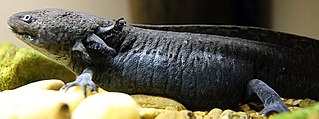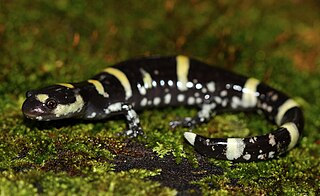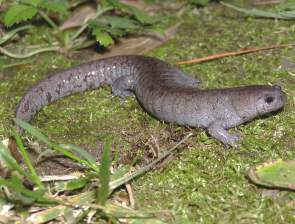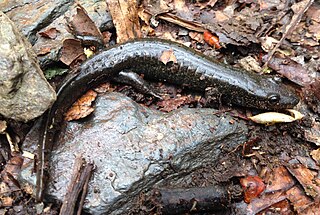
Salamanders are a group of amphibians typically characterized by their lizard-like appearance, with slender bodies, blunt snouts, short limbs projecting at right angles to the body, and the presence of a tail in both larvae and adults. All ten extant salamander families are grouped together under the order Urodela from the group Caudata. Urodela is a scientific Latin term based on the Ancient Greek οὐρά δήλη: ourà dēlē "conspicuous tail". Caudata is the Latin for "tailed ones", from cauda: "tail".

The axolotl is a paedomorphic salamander closely related to the tiger salamander. It is unusual among amphibians in that it reaches adulthood without undergoing metamorphosis. Instead of taking to the land, adults remain aquatic and gilled. The species was originally found in several lakes underlying what is now Mexico City, such as Lake Xochimilco and Lake Chalco. These lakes were drained by Spanish settlers after the conquest of the Aztec Empire, leading to the destruction of much of the axolotl's natural habitat.

The tiger salamander is a species of mole salamander and one of the largest terrestrial salamanders in North America.

The California tiger salamander is a vulnerable amphibian native to California. It is a mole salamander. Previously considered to be a subspecies of the tiger salamander, the California tiger salamander was recently designated a separate species again. The California tiger salamander distinct population segment (DPS) in Sonoma County and the Santa Barbara County DPS are listed as federally endangered, while the Central California DPS is listed as federally threatened. The Sonoma County, south San Joaquin, and the Santa Barbara County DPS have diverged from the rest of the California tiger salamander populations for over one million years, since the Pleistocene and they may warrant status as separate species.

The ringed salamander is a species of mole salamander native to hardwood and mixed hardwood-pine forested areas in and around the Ozark Plateau and Ouachita Mountains of Arkansas, Oklahoma, and Missouri. This species of salamander has slander body, small head, and long tail. They are usually found to have various dorsal color from dark gray to dark brown. Various close relatives are found such as marbled salamander and spotted salamander. This species of salamander has cannibal behavior especially those in large body size.

The streamside salamander is a species of mole salamander from North America, occurring in several Midwestern states of the US.

The frosted flatwoods salamander is an endangered salamander species native to the Southeastern United States.

The long-toed salamander is a mole salamander in the family Ambystomatidae. This species, typically 4.1–8.9 cm (1.6–3.5 in) long when mature, is characterized by its mottled black, brown, and yellow pigmentation, and its long outer fourth toe on the hind limbs. Analysis of fossil records, genetics, and biogeography suggest A. macrodactylum and A. laterale are descended from a common ancestor that gained access to the western Cordillera with the loss of the mid-continental seaway toward the Paleocene.

Taylor's salamander is a species of salamander found only in Laguna Alchichica, a high-altitude crater lake to the southwest of Perote, Mexico. It was first described in 1982 but had been known to science prior to that. It is a neotenic salamander, breeding while still in the larval state and not undergoing metamorphosis. The lake in which it lives is becoming increasingly saline and less suitable for the salamander, which is declining in numbers. The International Union for Conservation of Nature (IUCN) has rated it as being "critically endangered".

Anderson's salamander is a neotenic salamander from Zacapu Lagoon in the Mexican state of Michoacán.

The Lake Patzcuaro salamander, locally known as achoque, is a paedomorphic species of salamander found exclusively in Lake Pátzcuaro, a high-altitude lake in the Mexican state of Michoacán. First described in 1870 by Alfredo Dugès, the species is named in honor of the French herpetologist Auguste Duméril. However, the salamander has been used as a food source and an ingredient in traditional medicines by the Purépecha people since the Pre-Columbian era. Ambystoma dumerilii are neotenic, meaning they retain their larval characteristics throughout their entire life. This results in adults that have long, heavily filamented external gills, gill slits lined with tooth-like gill rakers, and caudal fins. When stressed, Ambystoma dumerilii can undergo an incomplete metamorphosis, though this is process significantly decreases their lifespan and is often fatal.

The marbled salamander is a species of mole salamander found in the eastern United States.

The blunt-headed salamander is a mole salamander endemic to Mexico. It is only known from the vicinity of its type locality, near Morelia, in Michoacán state in Southwestern Mexico. It inhabits a landscape consisting of a mosaic of natural grasslands and pine-oak forests at elevations of about 2,000 m (6,600 ft) asl. Breeding takes place in ponds. An average adult has a mass of 6.18 grams while wet. Adult females of the species range from 42-93 mm and males range from 45.4-70.5 mm in standard length.
The Puerto Hondo stream salamander or Michoacan stream salamander is a mole salamander from the Trans-Mexican Volcanic Belt within the Mexican state of Michoacán.

The small-mouth salamander is a species of mole salamander found in the central United States, from the Great Lakes region in Michigan to Nebraska, south to Texas, and east to Tennessee, with a population in Canada, in Pelee, Ontario. It is sometimes referred to as the Texas salamander, porphyry salamander, or the narrow-mouthed salamander. The Kelley's Island salamander was synonymized with A. texanum in 1995.

The barred tiger salamander or western tiger salamander is a species of mole salamander that lives in lower western Canada, the western United States and northern Mexico.

Ambystoma rivulare is a species of mole salamander in the family Ambystomatidae. Typically gains a lot of population distribution in the Trans-Mexican Volcanic Belt around central Mexico City. Found in various small or medium-sized ponds and lakes that have large and wide range of food options, all within a distance of at least 2 km. It is endemic to Mexico. Its natural habitats are subtropical or tropical moist montane forests and rivers. It is threatened by habitat loss. The larvae, who continue to prey on the same organisms as they grow, prey mainly on ostracods as well as some gastropods and assorted other prey with limited diversity. Ambystoma rivulare continue to live in the river they hatch in post-metamorphosis. Research on the Michoacan Stream Salamander has important implications for the conservation and persistence of these salamanders. The lack of variety in the A. rivulare diet puts them in a precarious situation should environmental factors endanger the ostracod population in their habitat. Further, a study done at the University of Sao Paulo on the diet of A. rivulare shows no relationship between size and the salamander's diet, suggesting a lack of larger prey for the bigger salamanders to eat.

The Tarahumara salamander is a freshwater species of mole salamander in the family Ambystomatidae, endemic to Mexico. Its natural habitats are temperate forest, subtropical or tropical moist montane forest, subtropical or tropical high-altitude grassland, rivers, freshwater marshes, pastureland, and ponds.

The plateau tiger salamander or Mexican tiger salamander is a species of mole salamander in the family Ambystomatidae. It is typically considered endemic to Mexico, although its range might extend to the United States. Its natural habitat is grassland, including sparse forest and semiarid grassland. Breeding takes place in a range of aquatic habitats: deep volcanic lakes, shallow vernal pools, artificial cattle ponds, and intermittent, fish-free stream pools. It exhibits facultative paedomorphosis.

The blackbelly salamander is a species of salamander in the family Plethodontidae. It is endemic to the United States. Its natural habitats are rivers, intermittent rivers, and freshwater springs. It is threatened by habitat loss.



















